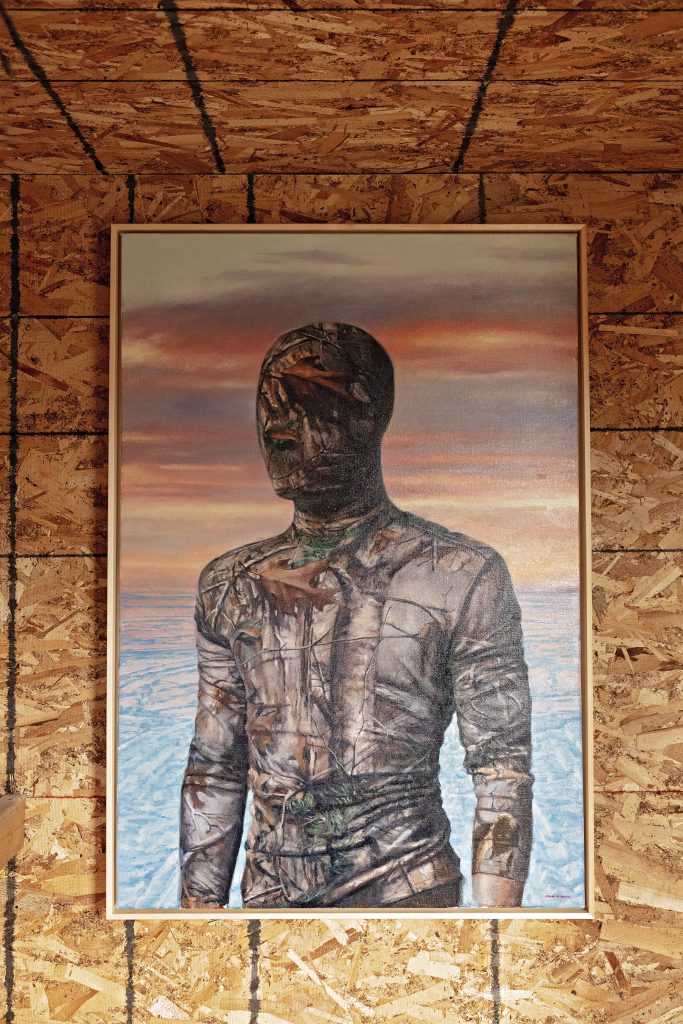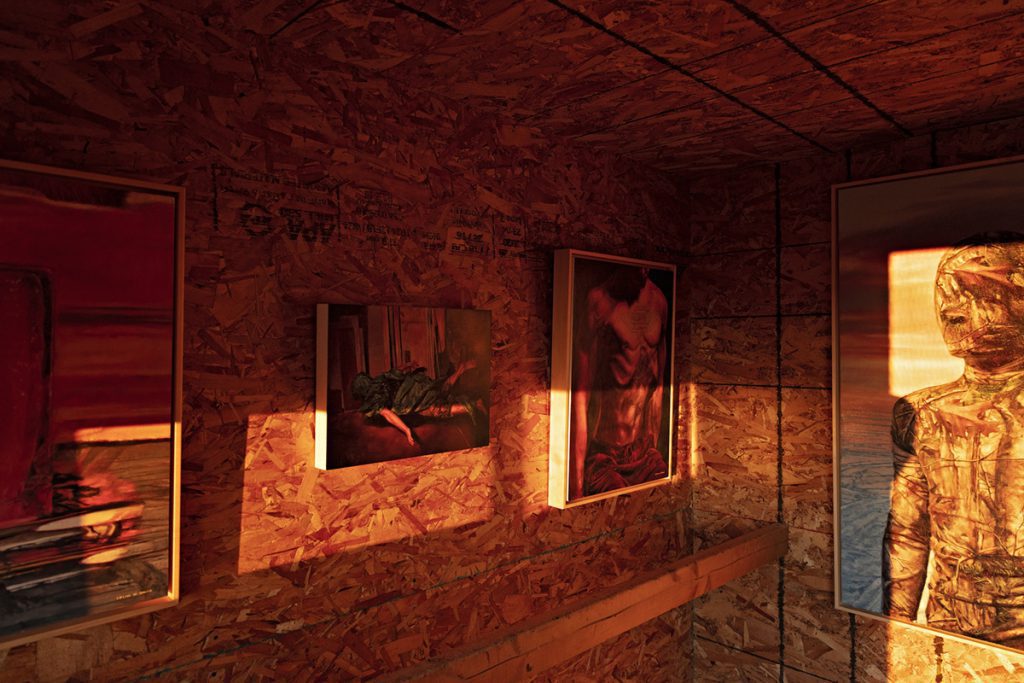A Rib Looks Like a Shoreline: Colin W. Davis at Between Pheasants Contemporary
12 May 2022
By Alex Gregory
The romantic urban dream of starting a commune, or quaintly living in cottage country, differs greatly from the reality of maintaining a prosperous farm. Such urban perceptions of rural living can seem out of touch, as country life comes with a responsibility to the land and to maintaining community values. This reinforces gendered expectations because, even with modern machinery, the success and economic prosperity of farming, forestry, mining, etc., requires immense physical labour that is stereotypically associated with cis-gender men. Additionally, rural activities such as fishing, hunting or dirt biking require grit, and facilitate a type of camaraderie that is associated with “bro-culture.”
Regardless of the problems inherent to the one-dimensional perceptions of pastoral professions and activities, these ventures not only support the livelihoods of people living in rural areas, but also provide the resources that construct and maintain cities. In A Rib Looks Like a Shoreline, a solo exhibition at the experimental project space Between Pheasants Contemporary (BPC) located in Kerns Township, Ontario, artist Colin W. Davis’ paintings visualize the internal tension derived from expectations for how masculine bodies relate to the social and material realities of living in northern rural communities. Through his ability to accurately depict form and meticulously replicate details (such as camouflage), Davis’ paintings reveal the stress inherent to performing rural masculinity while simultaneously giving attention to the serene beauty of the northern countryside.
Davis’ relocation from Toronto to North Bay allows him to observe the northern landscape while consciously performing rural masculinity. This, in part, results in hauntingly powerful oil paintings that capture the complexity of masculine performativity, as Davis is able to depict his subjects in intricate detail (such as replicating the texture of camouflage tarp and plywood) to create cohesive motifs. The work is exhibited in a pheasant coup on Windjammer Ranch (near New Liskeard); pheasants occupy the coup one half of the year, leaving the space empty and open for artistic possibilities in the remaining months. Horses and hens roam around the farm, while a tractor works the field near the coup—often shifting the position of the paintings inside of the coup. BPC has successfully integrated into the community, as farmers and locals frequent the gallery (following COVID-19 protocols). The exhibition space allows the work to keep its affective presence while utilizing virtual means of dissemination through their website with ample written and photographic documentation, as well as circulation through Instagram, further articulating the importance of virtual modes of communication for experimental art spaces that operate outside of city centres. The radical presentation forefronts the beauty and soft qualities of the work while also acknowledging the grit of Davis’s paintings—all qualities that would be washed out in sterile art spaces. The texture of the camouflage motif is similar to the texture of the particle board walls, creating depth for the warm colour palette and emphasizing blended brushwork in the paintings.

Davis’ paintings effectively produce a haunting presence as the figures’ faces are obscured with their bodies frozen in action, suspending time as they hold dynamic, active postures. Jiffy (2021) depicts a tense young man, breathing in, ribs flared, with a Jiffy brand ice auger (a drill used to cut holes in ice for ice fishing) tattooed on his chest. The upper half of his face is cut out of the frame, signifying that his individual expression is less important than his physical capabilities. Davis observes seemingly mundane utilitarian objects and reproduces them to reveal their material connections to rural expressions of masculinity. The tarp dominates the body in Figure with Green Tarp (2021), appropriately reversing the subject-object dichotomy. This reversal illustrates the trappings of performative masculinity, as well as the interconnection of bodies and the tools required to sustain bucolic existence. The objects depicted (ice, building materials, and brushwood bundles) are not stagnant, as human gestures are required to manipulate, extract, displace, and reassemble them. In Ice Hole and Pillar (2021), a block of ice sits on the surface of a frozen lake with a hole at the point of extraction, visualizing the labour required to go ice fishing. The soft colour palette of the melting ice block references the emotional drain of performative masculinity. Brush Painting (2020), a diptych, alludes to the social expectation of conforming to rural masculine tropes through the direct visual comparison of a hunter’s camouflage pattern to a bundled brush. A lifesize figure wearing a camouflage skin suit in Shaping, Shifting (2021) directly references the concealment of individual expression when performing a rugged character. The subjects portrayed are encapsulated by their surrounding objects, suggesting the physical and emotional labour required to exist in sylvan spaces.

Davis captures proportion and perspective effortlessly, but perhaps his more impressive talent is his ability to carefully reproduce the richness and depth of colours in the sky at dawn and dusk, while also representing the chilling atmosphere of colder climates. The meticulous mix of warm and cool conveys the strange bodily feeling of physically exerting yourself in sub-zero temperatures: when your chest is warm, but the tip of your nose and hands are freezing. Both Ice Hole and Pillar and Shaping, Shifting clearly occur at dawn/dusk, vividly visualizing the importance of ritual and renewal. Daily and seasonal cycles greatly affect the land, its inhabitants, and its custodians, as these cycles are essential to farming, planting, harvesting, and tending to the land—especially in winter when the days are short and cold. The exhibition’s documentation intentionally captures the show at various points throughout the day, foregrounding Davis’ perfectly blended colours and tones as they shift with the light. Between Pheasants Contemporary challenges the notions of rural masculinity not only by exhibiting marginalized artists (with an emphasis on queer artists), but by presenting artworks in a space that is familiar to farmers. The space has successfully integrated itself into the community, with local farmers making up the majority of visitors to the gallery. BPC isn’t just for those who idealize a quaint country life, or for habitual gallery patrons bored with the white cube. Davis’ paintings do not function as a scathing critique of rural masculinity—rather, they give light to the complexities embedded in identities that are easily flattened when viewed from solely an urban perspective.
A Rib Looks Like a Shoreline ran from April 10th – April 30th, 2021 at Between Pheasants Contemporary in Kerns Township, ON.
Feature Image: Installation view of Ice Hole and Pillar, Figure with Green Tarp, and Jiffy, all 2021 by Colin W. Davis. Courtesy of Between Pheasants Contemporary.



